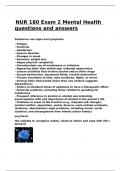NUR 180 Exam 2 Mental Health
questions and answers
Substance use signs and symptoms
~Fatigue
~Insomnia
~Headaches
~Seizure disorder
~Changes in mood
~Anorexia, weight loss
~Vague physical complaints
~Overabundant use of mouthwash or toiletries
~Appearing older than stated age, unkempt appearance
~Leisure activities that involve alcohol and/or other drugs
~Sexual dysfunction, decreased libido, erectile dysfunction
~Trauma secondary to falls, auto accidents, fights, or burns
~Driving while intoxicated (more than one citation suggests
dependence)
~Failure of standard doses of sedatives to have a therapeutic effect
~Financial problems, including those related to spending for
substances
~Frequent reference to alcohol or alcohol use indicating
preoccupation with and importance of alcohol in the person's life
~Problems in areas of life function (e.g., frequent job changes;
marital conflict, separation, and/or divorce; work-related accidents,
tardiness, absenteeism; legal problems, including arrest; social
isolation; and estrangement from friends and/or family)
psychosis
the inability to recognize reality, relate to others and cope with life's
demand
,Previous
Play
Next
Rewind 10 seconds
Move forward 10 seconds
Unmute
0:00
/
0:15
Full screen
Brainpower
Read More
Alcohol withdrawals signs, treatment, ASK WHEN THE LAST TIME
THEY DRUNK
Heavy drinkers of longer than 10 years are prone to developing
delirium tremens, a severe form of alcohol withdrawal that involves
sudden and severe physical, mental, behavioral, and nervous
system changes. Symptoms begin 48 hours to 10 days after the last
drink they worsen quickly and can include changes in mental
function, delirium, hallucinations, and seizures.Delirium tremens is
a medical emergency.Treatment and close monitoring in the hospital
setting required.
Entire motor area of brain depressed may want to lie down,
staggers loses conscious control of reason, easily angered way weep
Schizophrenia
a group of severe disorders characterized by disorganized and
delusional thinking, disturbed perceptions, and inappropriate
emotions and actions
The most common psychotic disorder
, care of a patient with schizophrenia
Individuals are admitted to an inpatient unit during acute psychotic
episodes, when they are a danger to themselves or others, or for
stabilization of disorganized or inappropriate behaviors. The goals
of inpatient care are to stabilize the client, prevent further decline
in functioning, and assist the client in coping with the disorder.
Long-term goals include psychosocial and vocational rehabilitation.
When available, family members are included in the care and
education of the client.
Neuroleptic Malignant Syndrome symptoms
*Symptoms of NMS begin with a sudden change in the dient's level
of consciousness and a rapid onset of rigid muscles. Often there is
an associated respiratory difficulty, tremors, and an inability to
speak. The cardinal sign of NMS is a high body temperature.
Temperatures can reach as high as 108°F, but usually range between
101° and 103°F. The temperatures of all clients receiving
psychotherapeutic drugs must be frequently and routinely
monitored. Without intervention, the client's physical condition
declines rapidly.
****Caregivers should suspect NMS in any client with signs or
symptoms of pneumonia or urinary tract infection. Clients who have
diaphoresis, tachycardia, an elevated white blood cell count, or any
muscle rigidity may be experiencing NMS. Sudden changes in
consciousness should always be investigated and reported.
Neuroleptic Malignant Syndrome Treatment
immediate withdrawal of antipsychotics, hydration, hypothermic
blankets, antipyretics, benzodiazepines, and muscle relaxants
No specific treatments exists for NMS.Supportive measures,
including intensive respiratory care, are instituted and all
medications that may have caused the development of NMS are
stopped
Neuroleptic Malignant Syndrome




